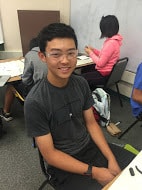Milestone 3/Final – My final milestone was to get the claw to work in conjunction with the motors. The motors were tough to work, and everyone doing the project realized, with three days to go, that we needed different motors and H-Bridges. The new H-Bridge was much easier to use, as all of the ports were labeled and we could just plug it in where necessary. This new H-Bridge would not overheat, like the previous one, and the motors had more torque, allowing the robot to move properly on the ground. Creating the final milestone was difficult, especially getting the “switch” mode to work properly. This “switch” mode is a mode that lets me switch between controlling the claw and the motors, because I don’t have enough gestures to do both at once. The problem with the switch mode was one finger could be slightly bent, and that would ruin the whole thing. The switch mode was based off a gesture, and if I bent a finger wrong than it would trigger accidentally, or not trigger when I wanted it too. I eventually got it to work, and it just felt so great to see everything come together. Just that final feeling of a job well done is one of the greatest things I have ever felt, and I feel that this entire program really inspires me to follow a career in engineering. Although it’s a bit early to say what I want to do for sure, I can say with passion that engineering, electrical engineering to be specific, is one of my top picks for a career later on in life.
Milestone 2 – My second milestone was assembling the glove, and then using it to move the claw. Using the flex sensors and certain gestures, I could get the claw to do certain things that I wanted, which I thought was really neat. The Arduino on the glove would receive readings from each flex sensor. It would map each of these values to a number, 1-7. It would send these values to the Arduino on the table, which would assign each of these values to a boolean – either true or false. Based on these boolean variables, a finger would be bent or unbent (True or False), and would let the claw know what to do. This is significant because it shows that I can get the claw which I am actually using to move. I can control it with the glove I am actually going to be using, so, in a way, I am partially done with the final product.
Milestone 1 – My first milestone was getting the two Xbees to communicate. By configuring them and getting them to work with each other, I could send messages through the respective terminals. This will be extremely important for my final project, because I will need the Xbees to communicate commands to move the servos and motors. It signifies that I can get them to communicate, and that is a significant step in my progress.
Starter – My starter project was the Mini Pov 4. The Mini POV works by first getting power from the battery pack. Once the on switch is turned on, the LED lights will begin to flash. It uses a ceramic oscillator to “time” the flashes and the rate at which the lights blink. There is a trim potentiometer, which looks like a blue knob. This can be adjusted to slow or increase the rate at which the lights blink. The black chip in the middle acts as the “brain” of the device. The device can be waved horizontally to create a picture. From this project I learned a ton. I learned what each of the components were and what they did, from transistors to the ceramic oscillators. I also learned how to solder, which I needed to complete the project.



